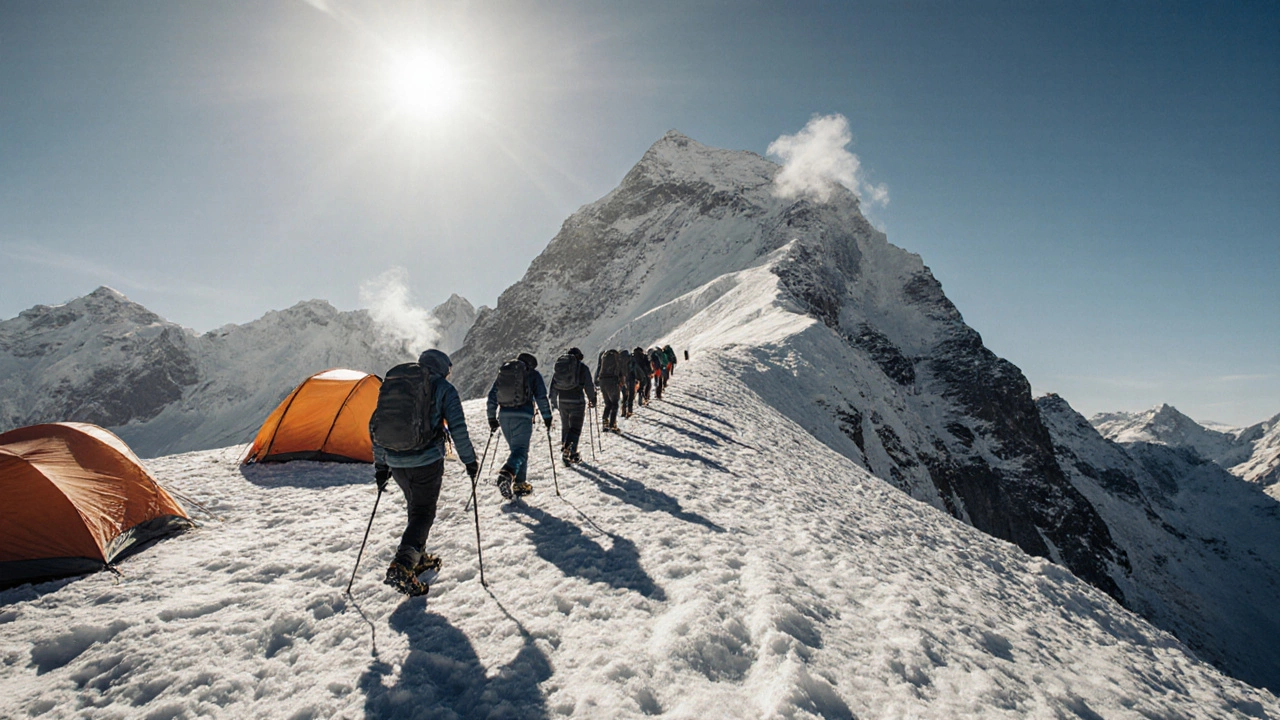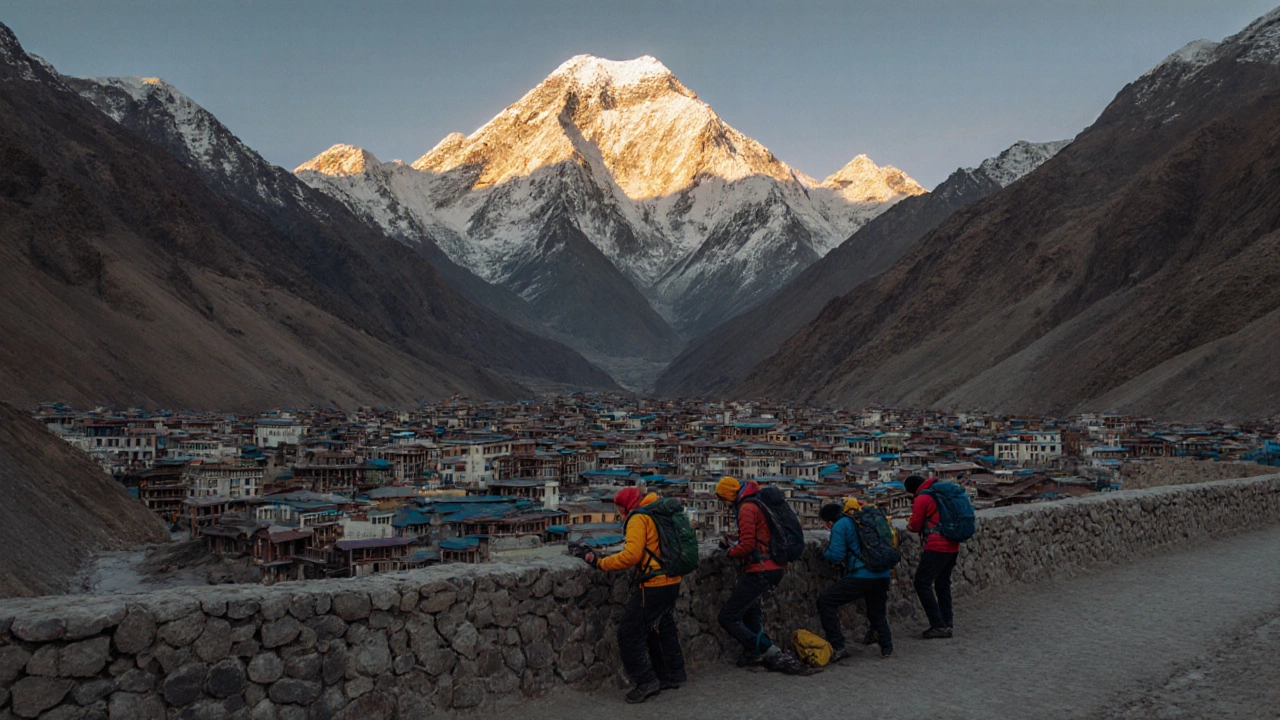Stok Kangri Trek Comparison Tool
The Stok Kangri Trek stands out as India's highest trekking destination at 6,153 meters, surpassing other notable routes like Goecha La (4,940m) and Kangchenjunga Base Camp (5,300m).
Unlike technical climbs, Stok Kangri requires no rope work, making it accessible to experienced trekkers seeking high altitude challenges.
- Maximum Altitude 6,153 m
- Difficulty Level Moderate-High
- Best Season June-September
- Permit Required Yes (IMF)
- Highest trekking altitude in India without technical climbing
- Well-marked trails suitable for experienced trekkers
- Unique panoramic views of Karakoram and Zanskar valleys
- Cultural immersion in Ladakh's Buddhist heritage
| Trekked Route | Max Altitude (m) | Typical Difficulty | Best Season | Permit Required |
|---|---|---|---|---|
| Stok Kangri Trek | 6,153 | Moderate-High (requires acclimatization) | June-September | Yes – IMF |
| Goecha La Trek (Sikkim) | 4,940 | Moderate | April-June, October-November | Yes – Sikkim Tourism |
| Kangchenjunga Base Camp (Sikkim) | 5,300 | High (remote, limited supplies) | April-June | Yes – Sikkim Tourism |
| Markha Valley Trek (Leh-Manali) | 5,150 | Moderate-High | June-September | No (restricted areas require permit) |
Quick Takeaways
- The Stok Kangri trek tops all Indian routes, reaching 6,153m (20,182ft) at the summit.
- It is a high‑altitude, moderately technical trek best attempted June‑September.
- Permits are issued by the Indian Mountaineering Foundation; a basic acclimatization plan is essential.
- Prepare for extreme cold, strong UV, and limited rescue options - proper gear and fitness are non‑negotiable.
- Compared to other legendary routes like GoechaLa or Kangchenjunga Base Camp, Stok Kangri offers the highest point reachable on foot in India.
When you hear “tallest trek in India,” most adventurers think of the soaring peaks of the Himalayas. While many routes touch 5,000m, only one consistently puts trekkers above 6,000m without requiring technical climbing gear: the Stok Kangri trek - a high‑altitude journey in the heart of Ladakh. This article breaks down everything you need to know, from the exact route and seasonal windows to gear lists, health tips, and how it stacks up against other great Indian treks.
What Makes Stok Kangri the Tallest Trek?
Stok Kangri is a 6,153m (20,182ft) peak in the Himalayan Range of western Ladakh. The summit is reachable by a defined trekking corridor that doesn’t demand rope work or advanced mountaineering equipment - just good fitness, acclimatization, and proper gear. Because the trail ends at the peak itself, no other Indian trek exceeds this altitude for a typical trekking party.
Route Overview
The classic approach begins in Leh, the capital of Ladakh, and follows a well‑marked trail through the villages of Stok and Shey before reaching the Stok Kangri base camp at 4,800m. From there, trekkers make a 2‑day push to the summit, typically via a high‑altitude bivouac at 5,800m. The total trek spans 70-80km round‑trip, with an elevation gain of roughly 3,500m.
Best Season and Weather Patterns
The window June to early September offers the most stable weather. July and August provide the warmest daytime temperatures (‑5°C to 10°C) and the lowest risk of snowstorms. However, even in summer, night temperatures can dip below ‑20°C, and sudden wind gusts are common. Planning the summit push for the middle of the season improves the odds of clear skies.

Permits, Regulations, and Safety
All trekkers must obtain a permit from the Indian Mountaineering Foundation (IMF). The process is straightforward: a copy of your passport, a recent photograph, and a nominal fee (≈INR500) are required. The IMF also enforces a strict “no single‑file” policy: groups must consist of at least three trekkers or hire a certified guide.
Because rescue services are limited in remote Ladakh, self‑rescue skills and a reliable satellite communicator (e.g., Garmin inReach) are essential. Altitude sickness is a real danger; a gradual ascent schedule with rest days at 4,200m and 5,200m is recommended.
Preparation Checklist
- Physical training: Build aerobic capacity with hill repeats, long runs, and strength work for legs and core. Aim for at least 10km of hiking on uneven terrain weekly for three months.
- Acclimatization plan: Spend a minimum of two nights above 4,000m before the summit day. Use the “climb high, sleep low” method.
- Medical clearance: Get a check‑up focusing on cardiovascular health, and carry a basic altitude‑illness kit (acetazolamide, ibuprofen, anti‑nausea medication).
- Gear list: Four‑season down jacket, insulated sleeping bag (‑20°C rating), trekking poles, crampon compatible boots (even though technical climbing isn’t required, they add safety on icy sections), UV‑blocking sunglasses, and a high‑SPF sunscreen.
- Communication: Satellite phone or messenger device, plus a local SIM for emergencies.
Comparative Snapshot: Stok Kangri vs. Other High‑Altitude Indian Treks
| Trekked Route | Max Altitude (m) | Typical Difficulty | Best Season | Permit Required |
|---|---|---|---|---|
| Stok Kangri Trek | 6,153 | Moderate‑High (requires acclimatization) | June‑September | Yes - IMF |
| Goecha La Trek (Sikkim) | 4,940 | Moderate | April‑June, October‑November | Yes - Sikkim Tourism |
| Kangchenjunga Base Camp (Sikkim) | 5,300 | High (remote, limited supplies) | April‑June | Yes - Sikkim Tourism |
| Markha Valley Trek (Leh‑Manali) | 5,150 | Moderate‑High | June‑September | No (restricted areas require permit) |
What to Expect on the Ground
Day‑by‑day, the trek mixes rugged desert‑like terrain with glacial streams and high‑altitude meadows. The first two days involve a gentle climb from Leh (3,500m) to Stok village (3,800m), giving your body time to adjust. Day3 traverses the Stok‑Shey route, crossing a river bridge and passing ancient monasteries that showcase Ladakh’s Buddhist heritage.
After setting up camp at 4,800m, trekkers spend a “rest day” for acclimatization - a perfect time to explore the nearby Stok Palace or practice yoga under the clear sky. The summit push starts pre‑dawn on Day5, climbing steep snowfields that become increasingly exposed. Reaching the summit offers a 360° panorama: the towering peaks of the Karakoram, the stark beauty of the Zanskar Valley, and on clear days, even the silhouette of Mt. Everest across the border.

Potential Pitfalls and How to Avoid Them
- Altitude sickness: Ascend slowly, stay hydrated, and be ready to descend if symptoms worsen.
- Weather surprises: Pack layered clothing, keep a waterproof shell, and always check the forecast before the summit day.
- Gear failure: Test all equipment at home; double‑check boot lacing and crampon fit before departure.
- Navigation errors: While the path is marked, high‑altitude whiteouts can hide cairns. Carry a GPS device with pre‑loaded waypoints.
Beyond the Summit: Extending Your Ladakh Experience
If you have extra days, consider adding a side‑trip to the Thiksey Monastery or a low‑altitude visit to the Pangong Lake. Both contrast the stark mountain environment with vibrant cultural and scenic highlights, enriching the overall adventure.
Frequently Asked Questions
Do I need technical climbing skills for the Stok Kangri trek?
No. The route is a trekking path, not a technical climb. Good fitness, proper acclimatization, and basic snow‑walking experience are sufficient.
How long does the trek usually take?
Most groups complete it in 6-7 days, including two acclimatization nights and a rest day before the summit push.
What is the cost estimate for a standard Stok Kangri trek?
A typical package (guide, meals, permits, and transport from Leh) ranges from INR35,000 to 45,000 per person, depending on the season and the level of comfort.
Can I do the trek without a guide?
While the IMF permits are issued to groups, it is strongly advised to hire a licensed guide. They know the route, help manage altitude risks, and handle emergency protocols.
What are the key health precautions?
Hydrate (3‑4L daily), avoid alcohol, and take prophylactic acetazolamide if recommended by a doctor. Monitor heart rate and oxygen saturation; descend immediately if you feel breathless or dizzy.
Final Thoughts
If you crave the thrill of standing on India's highest trekking point, the Stok Kangri trek delivers unmatched altitude, breathtaking vistas, and a cultural tapestry unique to Ladakh. By respecting the altitude, securing the right permits, and gearing up properly, you’ll turn a daunting challenge into a lifetime memory.
